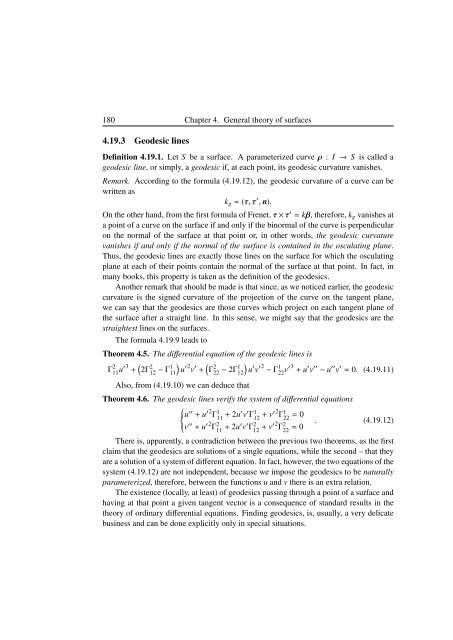Blaga P. Lectures on the differential geometry of - tiera.ru
Blaga P. Lectures on the differential geometry of - tiera.ru
Blaga P. Lectures on the differential geometry of - tiera.ru
You also want an ePaper? Increase the reach of your titles
YUMPU automatically turns print PDFs into web optimized ePapers that Google loves.
180 Chapter 4. General <strong>the</strong>ory <strong>of</strong> surfaces<br />
4.19.3 Geodesic lines<br />
Definiti<strong>on</strong> 4.19.1. Let S be a surface. A parameterized curve ρ : I → S is called a<br />
geodesic line, or simply, a geodesic if, at each point, its geodesic curvature vanishes.<br />
Remark. According to <strong>the</strong> formula (4.19.12), <strong>the</strong> geodesic curvature <strong>of</strong> a curve can be<br />
written as<br />
kg = (τ, τ ′ , n).<br />
On <strong>the</strong> o<strong>the</strong>r hand, from <strong>the</strong> first formula <strong>of</strong> Frenet, τ × τ ′ = kβ, <strong>the</strong>refore, kg vanishes at<br />
a point <strong>of</strong> a curve <strong>on</strong> <strong>the</strong> surface if and <strong>on</strong>ly if <strong>the</strong> binormal <strong>of</strong> <strong>the</strong> curve is perpendicular<br />
<strong>on</strong> <strong>the</strong> normal <strong>of</strong> <strong>the</strong> surface at that point or, in o<strong>the</strong>r words, <strong>the</strong> geodesic curvature<br />
vanishes if and <strong>on</strong>ly if <strong>the</strong> normal <strong>of</strong> <strong>the</strong> surface is c<strong>on</strong>tained in <strong>the</strong> osculating plane.<br />
Thus, <strong>the</strong> geodesic lines are exactly those lines <strong>on</strong> <strong>the</strong> surface for which <strong>the</strong> osculating<br />
plane at each <strong>of</strong> <strong>the</strong>ir points c<strong>on</strong>tain <strong>the</strong> normal <strong>of</strong> <strong>the</strong> surface at that point. In fact, in<br />
many books, this property is taken as <strong>the</strong> definiti<strong>on</strong> <strong>of</strong> <strong>the</strong> geodesics.<br />
Ano<strong>the</strong>r remark that should be made is that since, as we noticed earlier, <strong>the</strong> geodesic<br />
curvature is <strong>the</strong> signed curvature <strong>of</strong> <strong>the</strong> projecti<strong>on</strong> <strong>of</strong> <strong>the</strong> curve <strong>on</strong> <strong>the</strong> tangent plane,<br />
we can say that <strong>the</strong> geodesics are those curves which project <strong>on</strong> each tangent plane <strong>of</strong><br />
<strong>the</strong> surface after a straight line. In this sense, we might say that <strong>the</strong> geodesics are <strong>the</strong><br />
straightest lines <strong>on</strong> <strong>the</strong> surfaces.<br />
The formula 4.19.9 leads to<br />
Theorem 4.5. The <strong>differential</strong> equati<strong>on</strong> <strong>of</strong> <strong>the</strong> geodesic lines is<br />
Γ 2 11u′3 + � 2Γ 2 12 − Γ1 � �<br />
′2 ′ 2<br />
11 u v + Γ22 − 2Γ 1 �<br />
′ ′2 1<br />
12 u v − Γ22v ′3 + u ′ v ′′ − u ′′ v ′ = 0. (4.19.11)<br />
Also, from (4.19.10) we can deduce that<br />
Theorem 4.6. The geodesic lines verify <strong>the</strong> system <strong>of</strong> <strong>differential</strong> equati<strong>on</strong>s<br />
⎧<br />
⎪⎨ u<br />
⎪⎩<br />
′′ + u ′2Γ1 11 + 2u′ v ′ Γ1 12 + v′2Γ1 22 = 0<br />
. (4.19.12)<br />
= 0<br />
v ′′ + u ′2 Γ 2 11 + 2u′ v ′ Γ 2 12 + v′2 Γ 2 22<br />
There is, apparently, a c<strong>on</strong>tradicti<strong>on</strong> between <strong>the</strong> previous two <strong>the</strong>orems, as <strong>the</strong> first<br />
claim that <strong>the</strong> geodesics are soluti<strong>on</strong>s <strong>of</strong> a single equati<strong>on</strong>s, while <strong>the</strong> sec<strong>on</strong>d – that <strong>the</strong>y<br />
are a soluti<strong>on</strong> <strong>of</strong> a system <strong>of</strong> different equati<strong>on</strong>. In fact, however, <strong>the</strong> two equati<strong>on</strong>s <strong>of</strong> <strong>the</strong><br />
system (4.19.12) are not independent, because we impose <strong>the</strong> geodesics to be naturally<br />
parameterized, <strong>the</strong>refore, between <strong>the</strong> functi<strong>on</strong>s u and v <strong>the</strong>re is an extra relati<strong>on</strong>.<br />
The existence (locally, at least) <strong>of</strong> geodesics passing through a point <strong>of</strong> a surface and<br />
having at that point a given tangent vector is a c<strong>on</strong>sequence <strong>of</strong> standard results in <strong>the</strong><br />
<strong>the</strong>ory <strong>of</strong> ordinary <strong>differential</strong> equati<strong>on</strong>s. Finding geodesics, is, usually, a very delicate<br />
business and can be d<strong>on</strong>e explicitly <strong>on</strong>ly in special situati<strong>on</strong>s.












